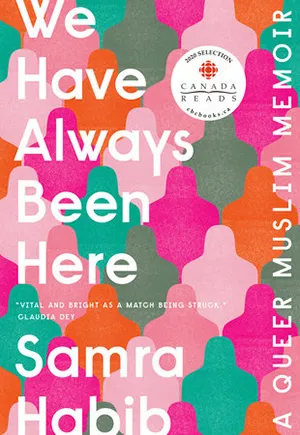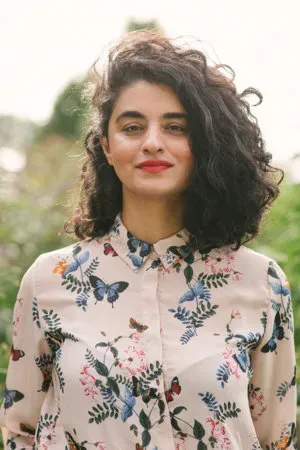Religion and LGBTQ+ communities have always seemed to be at odds, as ancient texts often challenge and condemn the very existence of Queer people. In her memoir We Have Always Been Here, journalist Samra Habib recounts her journey to self-discovery and acceptance as a Queer woman, a Muslim, and an immigrant to Canada.
Habib's early days in Pakistan
Habib starts her book with stories detailing her early childhood in Pakistan. In her Muslim community, women were to remain quiet. Habib relates her mother's attempts to hide her own joy from male disciplinarians, such as her husband. Throughout the early sections of the memoir, Habib also recounts her experiences with childhood sexual assault and reflects on the ways her gender made her a victim in her parents' eyes.
"Grown-ups, who are supposed to protect their children, are limited by what 'best' has felt like to them, based on the circumstances they grew up in and the privilege they did or did not have," she said, reflecting on how her parents tried to protect her in the ways they knew.
Habib describes the process of immigration to North America as a preteen, fleeing oppression of her family's sect of Islam. She contrasts the everyday experiences of her young teenage years – from exploring fashion to getting her first period – against the backdrop of experiencing racism and islamophobia as an immigrant and the struggles of growing up in a strict Muslim household.

"First-born-daughter syndrome"
Habib reveals that at the age of 13, she found out her mother had betrothed her to her first cousin, a 23-year-old at the time. As she reckoned with her future being determined for her, she struggled to understand how to grasp her own identity as a woman and a feminist.
For Habib, rejecting her betrothal meant a rejection of her family and culture. She described a feeling many immigrants encounter: being torn between Western liberal ideals and a loyalty to one's family and heritage. In the end, she chose her family, still determined to fill their expectations for her. However, in making this decision, even at a tender age, Habib felt responsible for her fate as a child bride. "I started to internalize my mother's belief that my lack of resistance was my way of consenting and that I was responsible for what had happened," she wrote.
As the eldest daughter, Habib experienced a phenomenon known by psychologists as "first-born-daughter syndrome." Melvin Wong, a psychiatrist, describes women, like Habib, who experience this phenomenon as "emotionally and physically abused. The use of shame, divisiveness, splitting, favoritism, nepotism, and threats of separation and dread are commonalities in their upbringing."
Habib's choice to marry her cousin reflected the "good girl" image she put on for her family throughout the first half of the book. Desperate for approval, she sacrificed her own needs and desires to be her parents' "angelic, selfless daughter."
Habib describes the experience of eldest-daughter burnout, which took a toll on her mental health, as she realized she had sacrificed her entire identity to conform to her parents' expectations of her. She candidly admits feelings of jealousy for her younger sisters, who were given freedom over their futures in a way she never was.
Habib's frustrations with the childhood abuse and neglect she faced reached a culmination in her late teens. She admitted to her family she no longer wanted to be married to her cousin, and while they allowed her to divorce, her community was unable to see her the same way again. Sacrificing the unattainable label of the perfect daughter, she succumbed to years of repressed angst and eventually ran away from home.
Searching for Muslims in Queer spaces
Habib's experiences of going from "perfect daughter" to disgraced rebel reflect a common experience of eldest or gifted children. The desire for acceptance leaves many sacrificing their growth, stunting themselves into a mold of parental expectations.
Habib's story grows more complex, however. After entering another young marriage with her first boyfriend, Habib realized she did not enjoy sex with her new husband. She concluded that she was Asexual.
Detached from her family and culture for the first time in her life, she explored the world around her. She met Queer people and discovered a community to which she was instantly drawn.
Ultimately Habib made the connection that she is Queer. While her story could have opened up in a grand romance, she instead chose to describe her intimate love for the LGBTQ+ community as a whole, praising it as a space where "two people whom society rejected, dismissed, and disapproved of [dare] to be seen, [dare] to be in love even when we were told we weren't allowed to be."
However, she also found a longing for something more. "It seemed that no one in Queer spaces I visited – dance parties, art shows, Pride events – was curious about why there were hardly any people of color – and hardly any Muslims – in their midst. I felt even more invisible," she writes.
Overwhelmed by the white Queer spaces she encountered in Canada; Habib sought out ones where she could find solidarity with Queer and Trans people of color. However, even there, she realized that her Muslim upbringing set her apart from the others. "I wasn't seeing the Queer Muslim narratives I was hungry [to occupy] the spaces I frequented."
Picturing a new age of representation
And so, Habib set off on a new journey, one of rebuilding and rediscovering. She began by reaching out to an LGBTQ mosque, where she encountered people who, like her, felt a simultaneous rejection from and desire to be a part of Muslim culture. Through her experiences in the mosque, Habib was able to regrow her spirituality and find ways her religion could connect with her Queer identity.
Inspired by her friends at the mosque, and spurred by a lack of Islamic representation in LGBTQ+ media and studies, Habib launched her next project. Over several years she began reaching out to and recording the stories of other Queer Muslims. Traveling across the world, she made connections with diverse people and brought the conversation around religion and queerness to publications such as The Guardian and the New York Times.
Soon after starting her project, Habib realized that documenting LGBTQ+ Muslim representation would be uniquely challenging, but she felt it was vital informing her community. "Representation presented another challenge: historically, photography has been prohibited within Islam," she writes. "Prophet Muhammad has been noted as saying, 'The most severely punished people on the Day of Resurrection will be those who make images.' Not surprisingly, given that very explicit message, it's almost impossible to find photographic evidence of the existence of Queer Muslims."
Despite these challenges, she was determined to connect with others who shared her experience. Like many people who find themselves at the impasse of identity intersections, Habib felt isolated. Her queerness kept her from existing in the same cultural and religious spaces her family belonged to, and her culture and religion meant that not many LGBTQ+ people found common ground with her.
Elevating Queer voices
Her journey to forging community was inspired not only by her personal desire to feel accepted but also by an awareness that Queer people exist all over the world, including in the Pakistani hometown her family had fled. As challenging as acceptance was for Habib, she knew that reaching out to others like her around the world could mean the difference between life and death.
"We have always been here," one of her interviewees declared. "It's just that the world wasn't ready for us yet. Today, with all the political upheavals in the Muslim world, some of us, those who are not daily threatened with death or rejections, have to speak for others."
As she forged a community, Habib realized there were even more intersections to Queer Muslim identity that needed to be highlighted in her photo project. "It was important for me to ensure that the voices of Queer Muslims who were Black and Trans were included in my project, to show the additional layers of systemic discrimination beyond islamophobia," she writes.
Coming out
Her newfound community gave Habib something she had spent her entire childhood and young adult life searching for: validation. Through the eyes of others, she was able to see herself as a strong feminist and activist, a good Muslim, and a staple of her Queer community. Armed with the support of her found family, Habib finally felt ready to come out to her parents and accept their criticism and judgment.
Instead, she found love and acceptance.
In her touching account of her coming out, Habib notes that not only did she grow up and embrace progressive ideas about sexuality and gender in her time in Canada, but her parents had also broadened their worldviews since her childhood. Her mother accepted her with open arms.
"For the first time in my life, I felt the warmth of unconditional love," Habib writes of the experience.
We Have Always Been Here is a touching story of growing up, finding a home, and discovering oneself against the backdrop of cultural and familial expectations. It is a powerful book that will resonate with anyone who has felt a sense of "eldest child syndrome" or allegiance to a culture or community that doesn't quite make space for them.


